soba
What Is Soba? A Guide To Japanese Buckwheat Noodles
Christian Closs
Posted on February 17, 2022
Share:
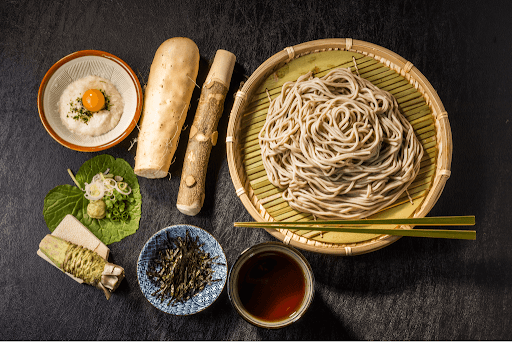
Noodles are a staple of Japanese cuisine, popular for their versatility just as much as the multitudes of textures they offer. While soba noodles often take a backseat compared to ramen and its regional varieties as a Japanese culinary export, they are hugely popular across Japan with many local variations and specialties.
History of Japanese Soba
The exact arrival of buckwheat in Japan is hard to establish, however there are records mentioning food made from its flour from the 8th century onwards. Initially it was not eaten in noodle form and instead as a kind of dumpling or cracker, until the city-dwellers of Edo, present-day Tokyo, discovered its versatility for a quick meal in the early 17th century.
While soba noodles initially became a hit as a kind of fast food for an accelerating pace of life in Edo, they quickly spread all over the country. Today it can be found anywhere in Japan, with endless regional varieties and specialties.
Curious to try unique Japanese flavors from regions all across Japan sent straight to your door? Check out Sakuraco. Sakuraco sends authentic Japanese snacks, tea, and sweets from local makers right to you!
Ingredients and Ways to Serve
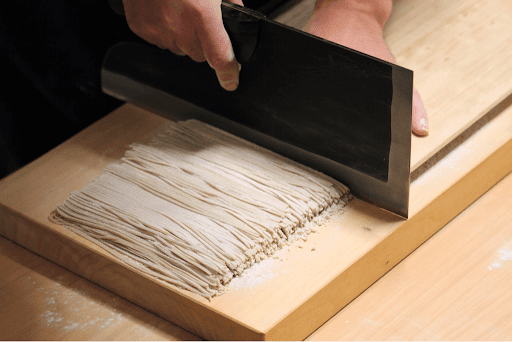
Originally, only buckwheat flour was used to make soba noodles, but many shops realized that adding some wheat flour makes the noodles less brittle. It is also worth noting that there are some Japanese noodle dishes containing the word ’soba’ which in fact do not contain any buckwheat at all, such as yakisoba or chukasoba. While these are wheat flour noodles, more often than not, the name by itself usually refers to buckwheat noodles.
They’re eaten year-round, sometimes to mark special occasions like Japanese New Years, but always in one of two ways: Hot, with the noodles submerged in broth, or cold, with the noodles drained after cooking and served separately to be dipped into a specific sauce. Let’s have a look at some dishes for each category:
Hot Soba
Hot soba is popular year round and usually served with the noodles submerged in a broth called tsuyu. Tsuyu is made by combining dashi, a fish stock, with sweet soy sauce and mirin, a rice wine used for cooking.
Kakesoba
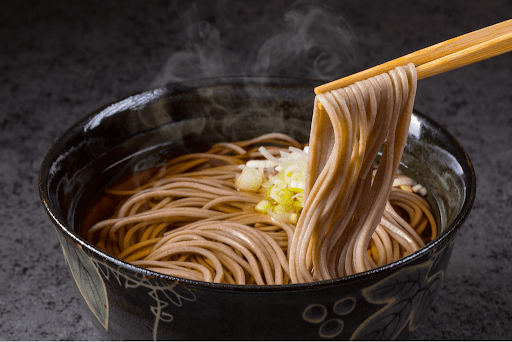
The simplest way to have a hot bowl of soba. ‘Kake’ means ‘to pour over’ and that is exactly what happens. Hot broth is poured over the noodles, with usually just scallions added as a topping. Cheap, simple and available almost anywhere in Japan.
Sansai Soba
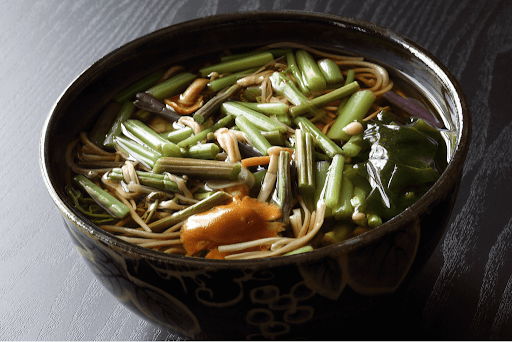
Sansai can literally be translated as ‘mountain vegetables’ and that is exactly what one can expect to find on top of this noodle dish. Edible plants that naturally grow in the wild such as bamboo shoots, bracken and ferns are used, with mushrooms frequently in the mix. Since the ingredients need to mostly be foraged this tends to be served as a spring dish.
Kitsune Soba
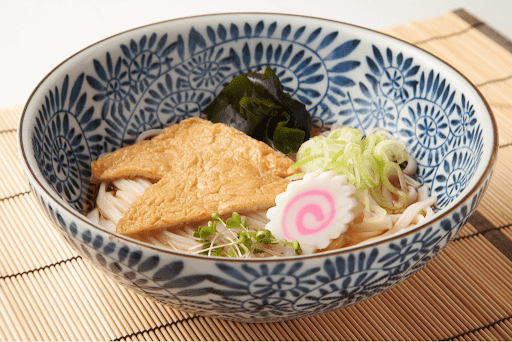
Thin, slightly sweet sheets of fried tofu are found on top of the noodles for this dish, usually cut in characteristic triangle shape. They are often accompanied by slices of kamaboko, a steamed fishcake.
Cold Soba
Cold Soba is most popular during the summer months, but available year round and especially appreciated by noodle enthusiasts. At the height of summer it is not uncommon to find some ice cubes in your bowl to further chill the noodles.
After cooking the noodles they are served on a bamboo tray, allowing excess water to drip down. The noodles are then dipped into a tsuyu broth, which is much stronger than the one used for hot soba. Chopped scallions and wasabi can also be added. After finishing the noodles it is common to mix the water used for cooking the noodles with any leftover tsuyu and then drinking it.
Hadaka Soba
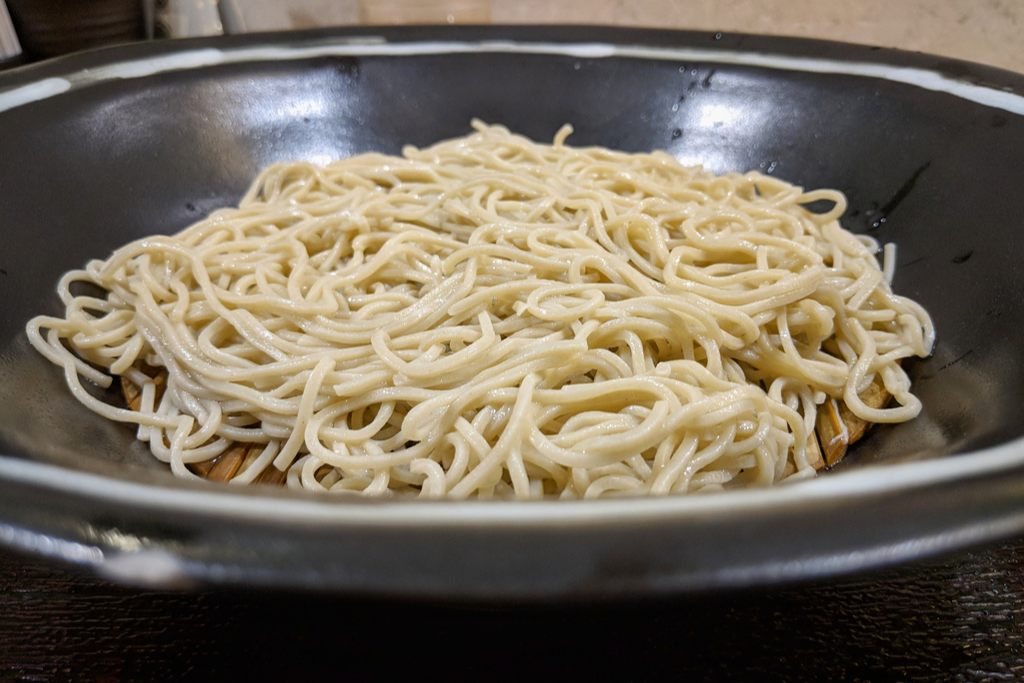
The simplest kind of chilled noodles, with hadaka literally meaning naked. Cooked, drained and then served cold with no toppings or sauce. Truly one for the enthusiasts out there.
Zaru Soba
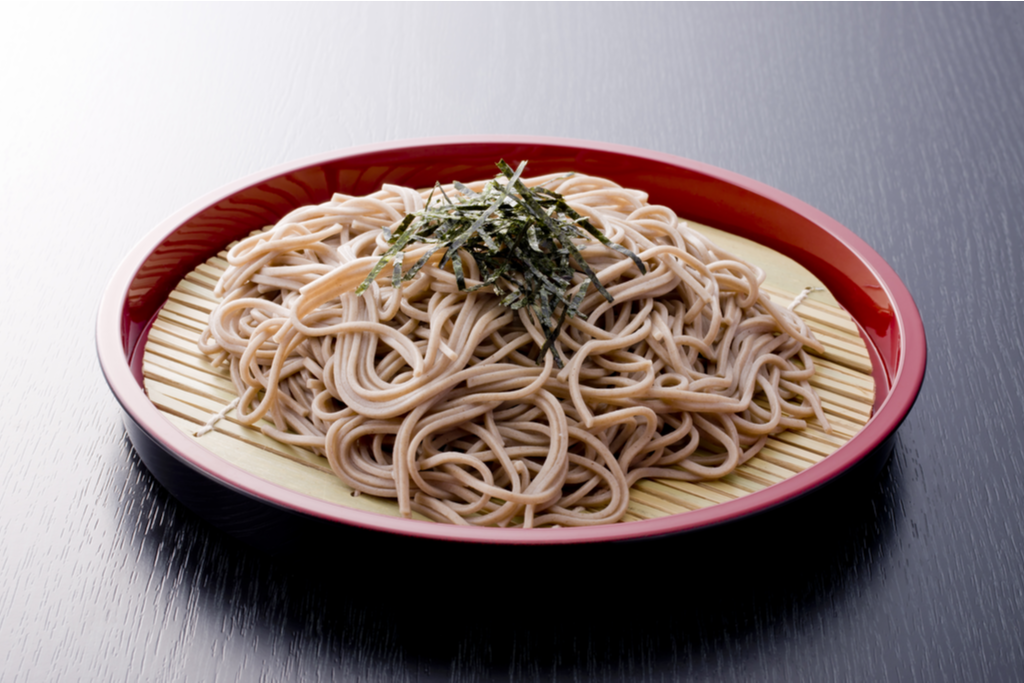
A little less pure and much more common than hadaka, zaru-style buckwheat noodles come with added dipping sauce and often sprinkled with dried nori seaweed. Extremely popular in summer.
Cha Soba
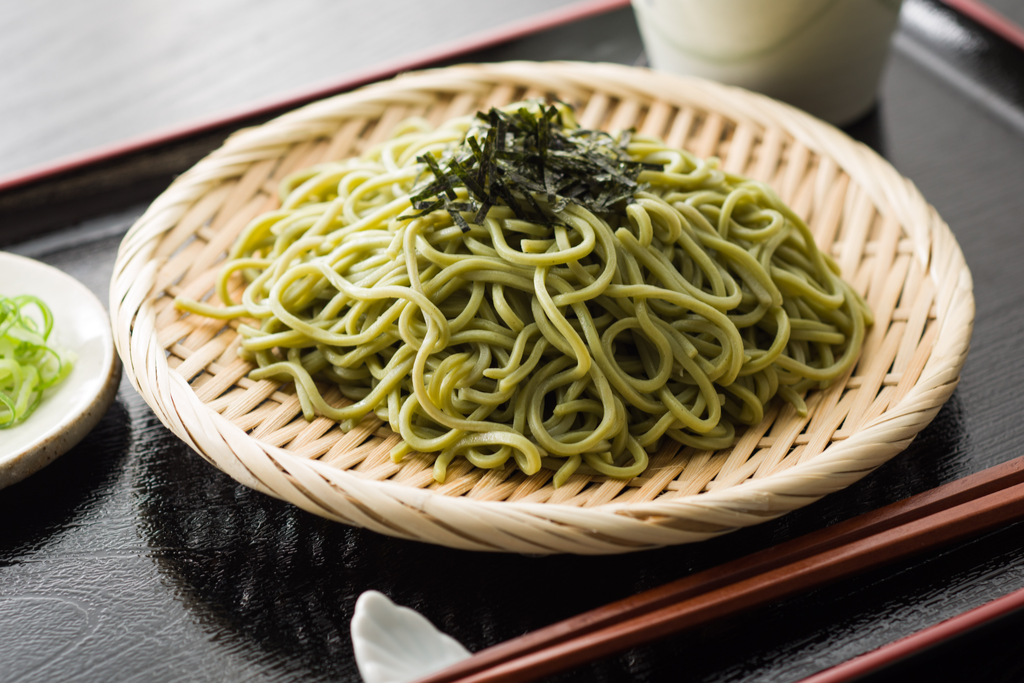
A great example for the various recipes you can make, cha-style noodles involves adding matcha green tea powder to the buckwheat flour mix, adding a deep green color and green tea aromas. Similar to zaru-style with dipping sauce, this one is another summer specialty and somewhat rare treat.
These varieties are only the tip of the iceberg, with many, many more available all over Japan. Restaurants continue to look for new ways to make and serve these noodles and regional specialties are everywhere. We definitely recommend you to try out some soba on your next trip!

Discover authentic flavors with Sakuraco
Get Sakuraco 
2 Responses

Discover authentic flavors with Sakuraco
Get Sakuraco 
Related Articles

Mochi: How is Mochitsuki Made in Japan?
Mochitsuki is the Japanese tradition of pounding steamed rice to make mochi for the New Year. Families and neighbors gather to participate in this lively and meaningful tradition. The teamwork involved helps everyone feel a sense of connection.

Konpeito Candy: What Makes This Starry Treat Shine?
If you are a fan of the famous Demon Slayer series, then you probably know that the favorite treat of the adorable Nezuko Kamado is those tiny, colorful little sweets.

Kinako: The Amazing Roasted Soybean Powder!
Kinako is a very popular ingredient that can easily be found in many traditional Japanese sweets. It has a distinctive flavor, standing alongside other classic tastes such as red bean or sesame. Let’s explore this charming ingredient together, and who knows, you might even be able to make it in your own beloved kitchen!

Aaron and Claire Make the Ultimate Japanese Pork Belly: Buta no Kakuni
If you want a Japanese dish that’s rich, tender, and simple to follow, Aaron and Claire show exactly how to make it in this episode. Aaron prepares Buta no Kakuni, a classic braised pork belly dish renowned for its rich flavor and tender texture.



I love learning about the Japanese heritage and culture. This one was very well presented and I enjoyed it very much.
I try working Japanese foods into the western culture and I am quite amazed with how well they combine.
In fact I make a Japanese dashi broth as a base for many of my dishes with much success in taste.
Any future articles you may send would be greatly appreciated
Frederick Brave
Thank you Frederick! I’m glad to hear that you enjoyed our articles! Would love to hear more about Japanese and Western dishes that you’ve made so far~ 🥰